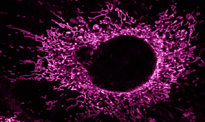Research
Mitochondria are the main energy producing stations within our cells. Over three decades ago Hartman was one of the first to propose that mitochondria play a central role in ageing. The initial theory suggested that ageing, as well as the associated degenerative diseases, could be attributed to the deleterious effects of reactive oxygen species (ROS) on various cell compartments. The fact that the mitochondrial electron transport chain is the major site of production of reactive oxygen species has lead to the suggestion that mitochondria are a prime target for oxidative damage and hence the mitochondrial theory of ageing, a correlate of the free radical theory. This idea is intellectually very appealing, as mitochondria are the only organelles in animal cells that possess their own DNA, mtDNA, localized in the physical proximity to the respiratory chain, allowing irreversible damage to be introduced. The mitochondrial theory of ageing is based around the idea that mitochondrial DNA (mtDNA) mutations accumulate progressively during life and are directly responsible for a respiratory chain dysfunction that leads to an impaired bioenergetic homeostasis and an enhanced production of free oxygen radicals.
Recently, we have made a considerable progress in understanding basic role of acquired mtDNA mutations in ageing by generating the mtDNA mutator mice. The creation of mtDNA-mutator mice has provided the first direct evidence that accelerating mtDNA mutation rate can result in premature ageing, consistent with the view that loss of mitochondrial function is a major causal factor in ageing. Furthermore, we showed that there is no direct connection between increased mtDNA mutation load and elevated ROS production, arguing against a direct role of oxidative stress in the ageing process.
The main focus of our group is to understand the role of mitochondrial (dys)function in the determination of longevity. We are also interested in understanding molecular mechanisms by which mitochondria contribute to development and progression of age-associated diseases. We are studying these complex aspects of mitochondrial biology using two different model systems: transgenic mice and a roundworm, Caenorhabditis elegans.

